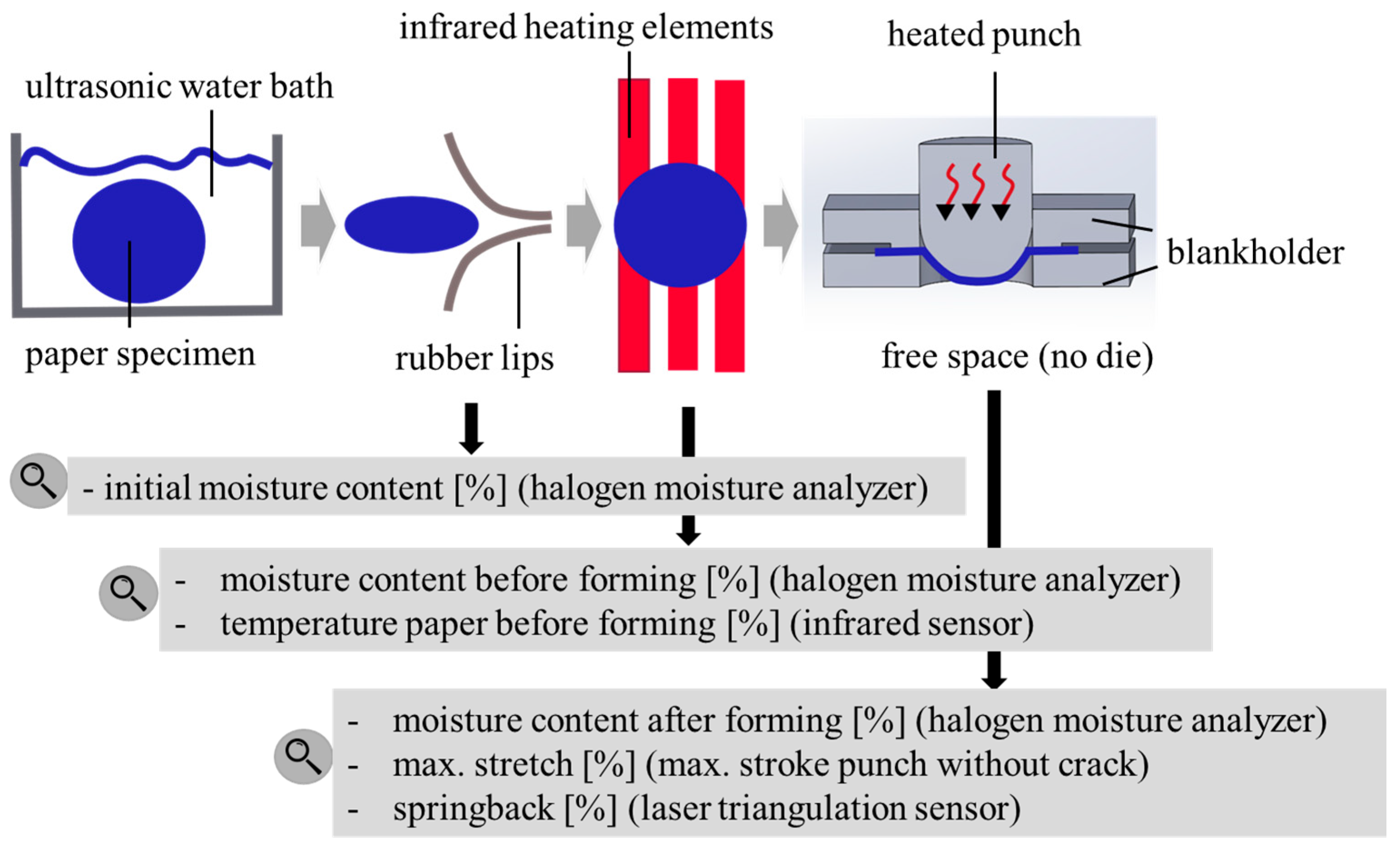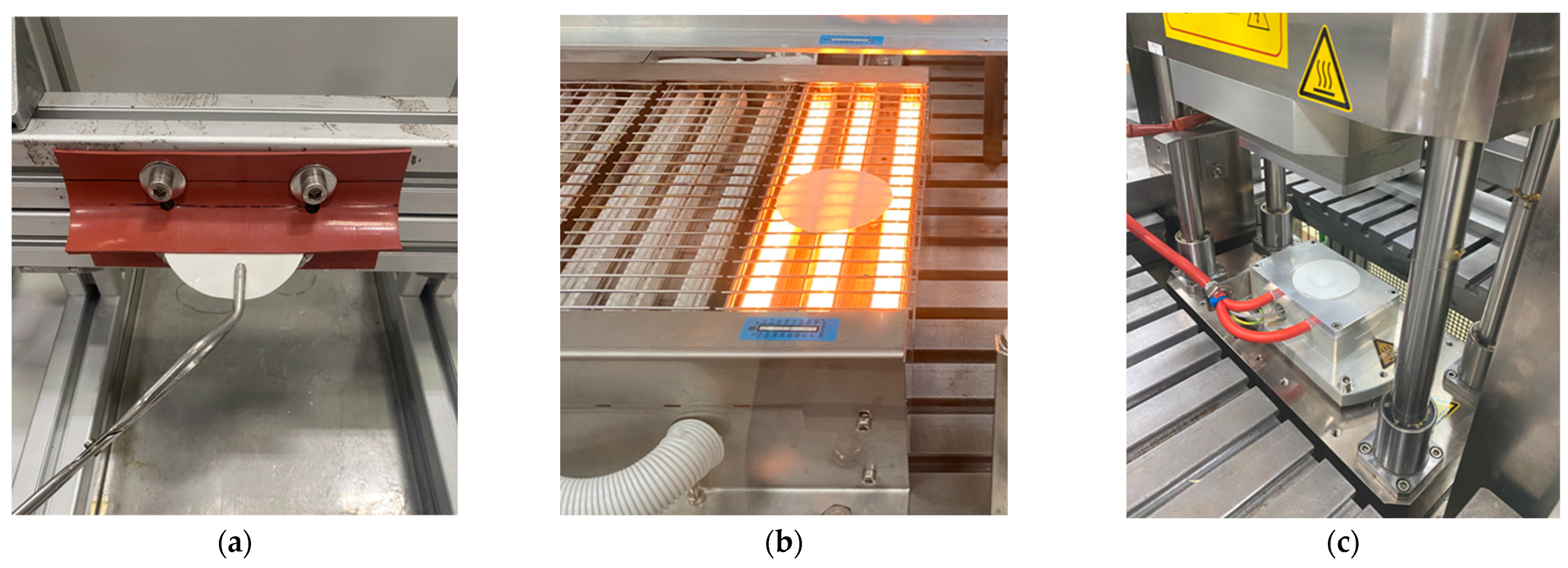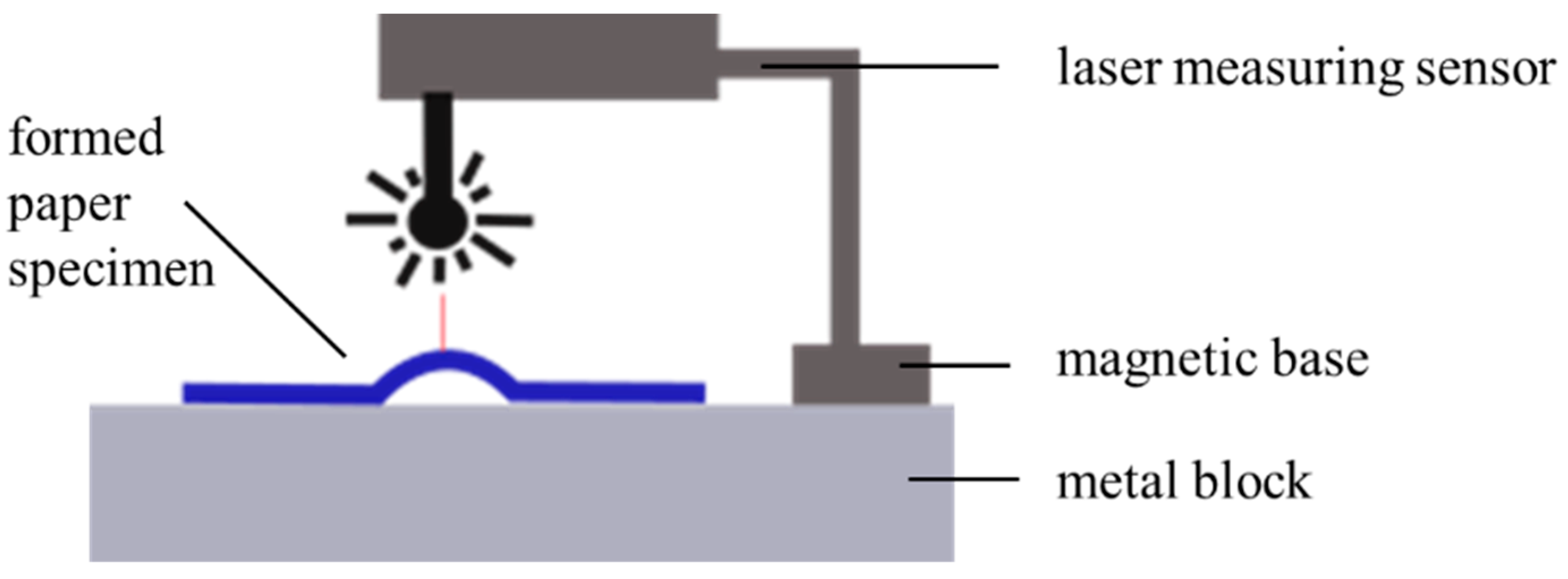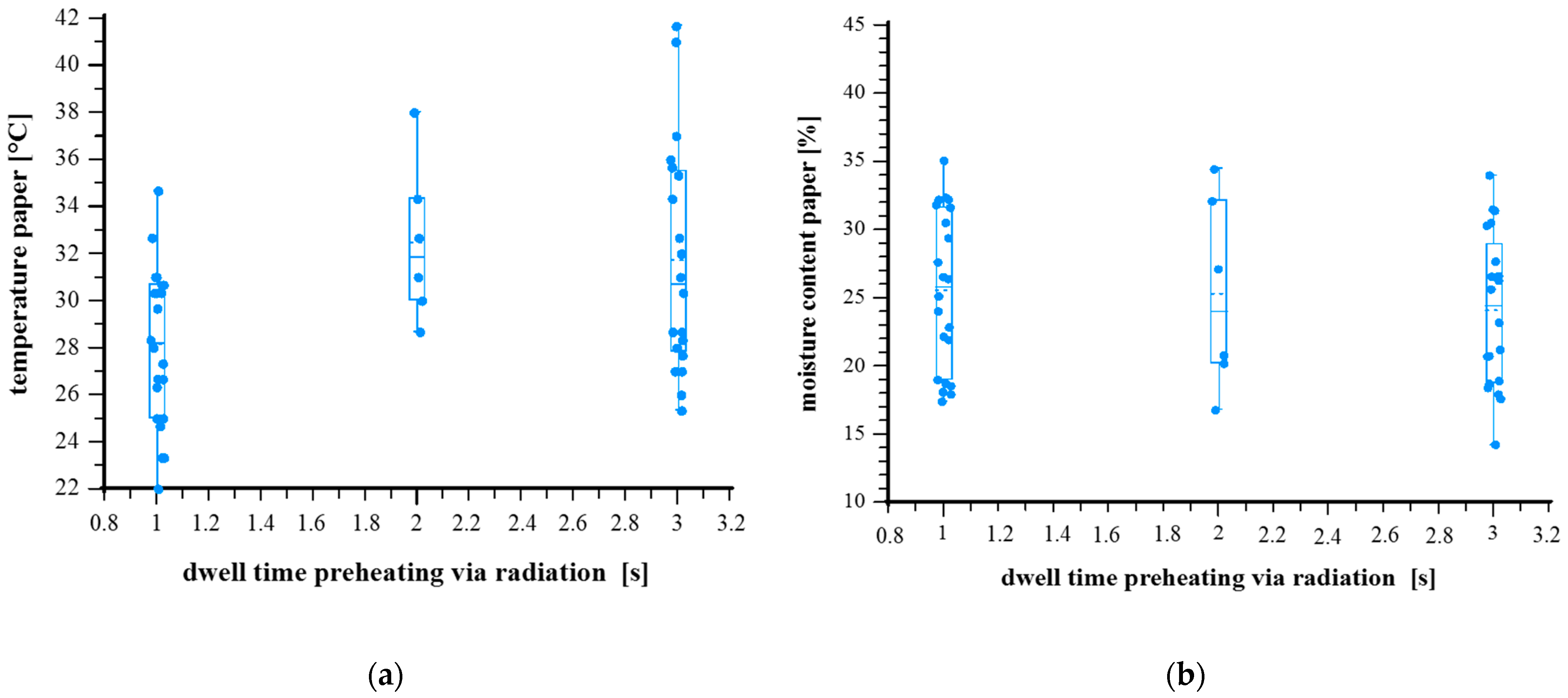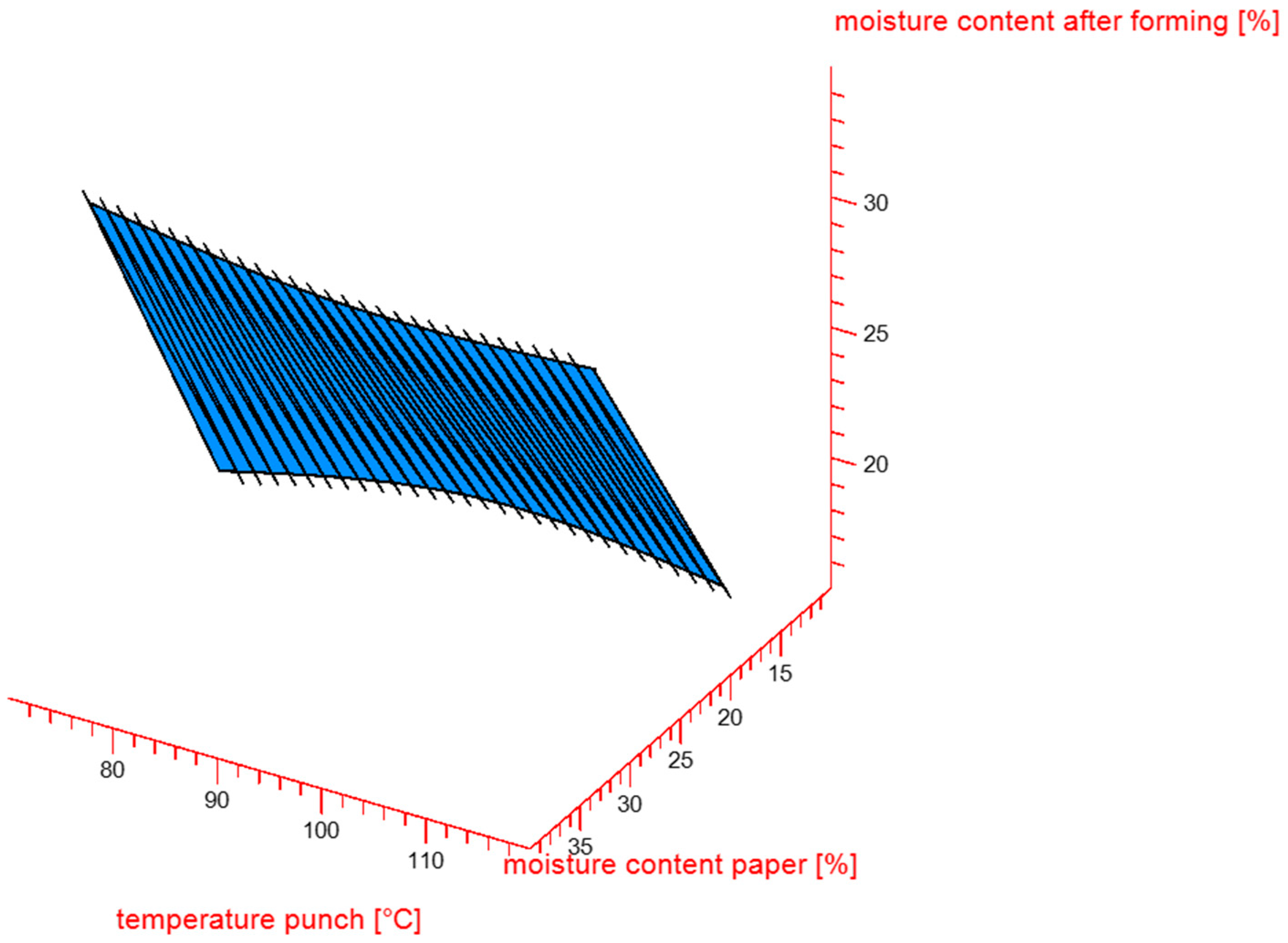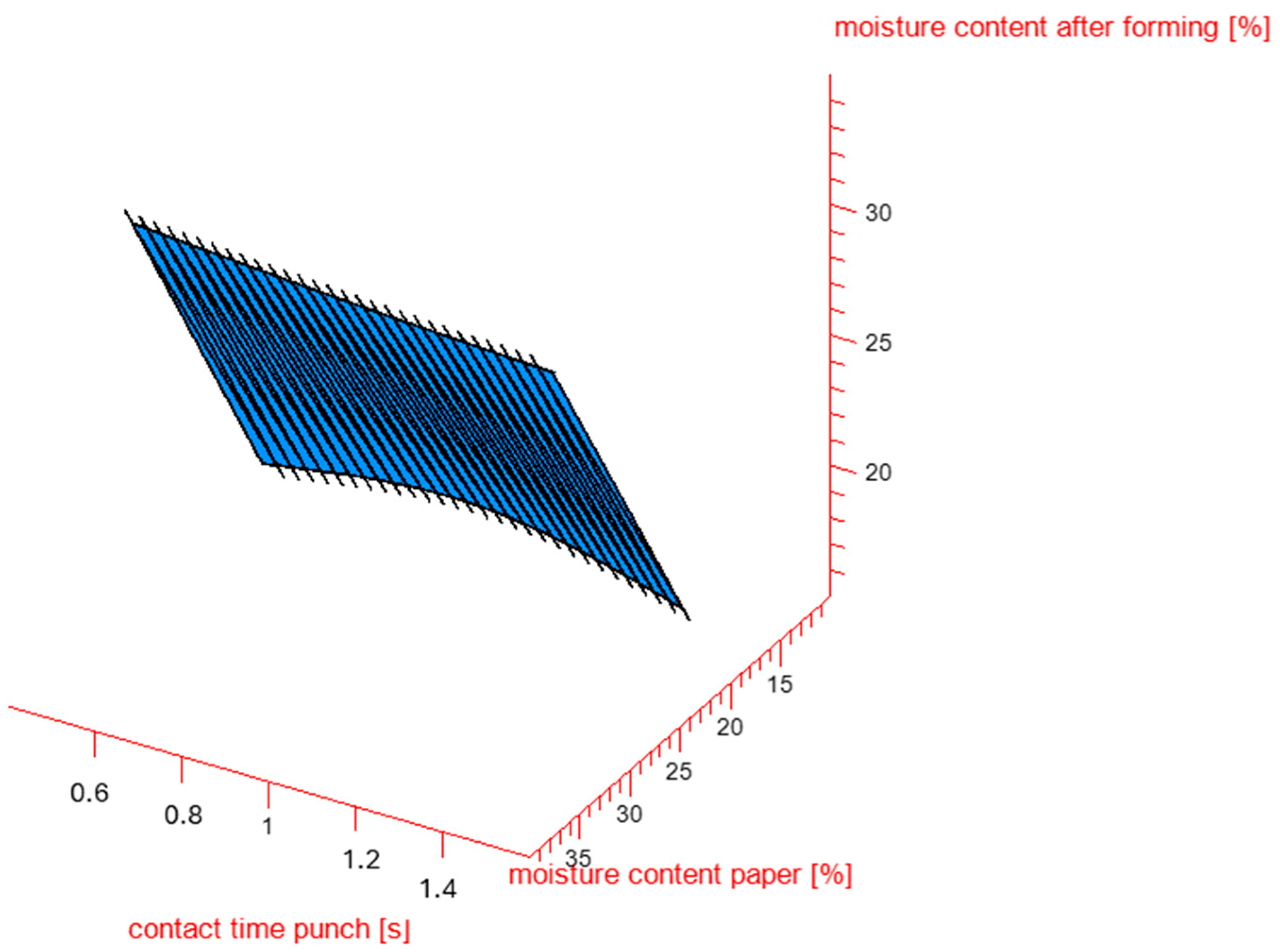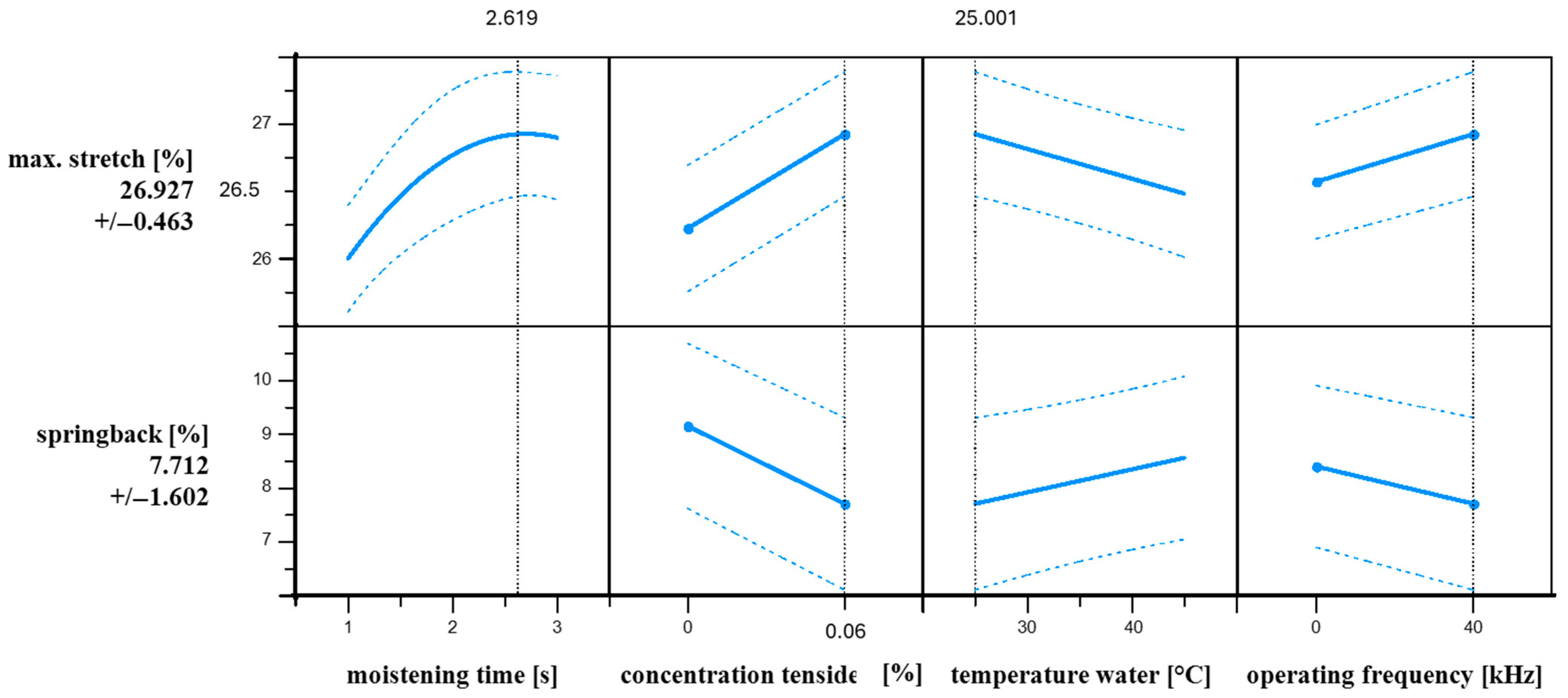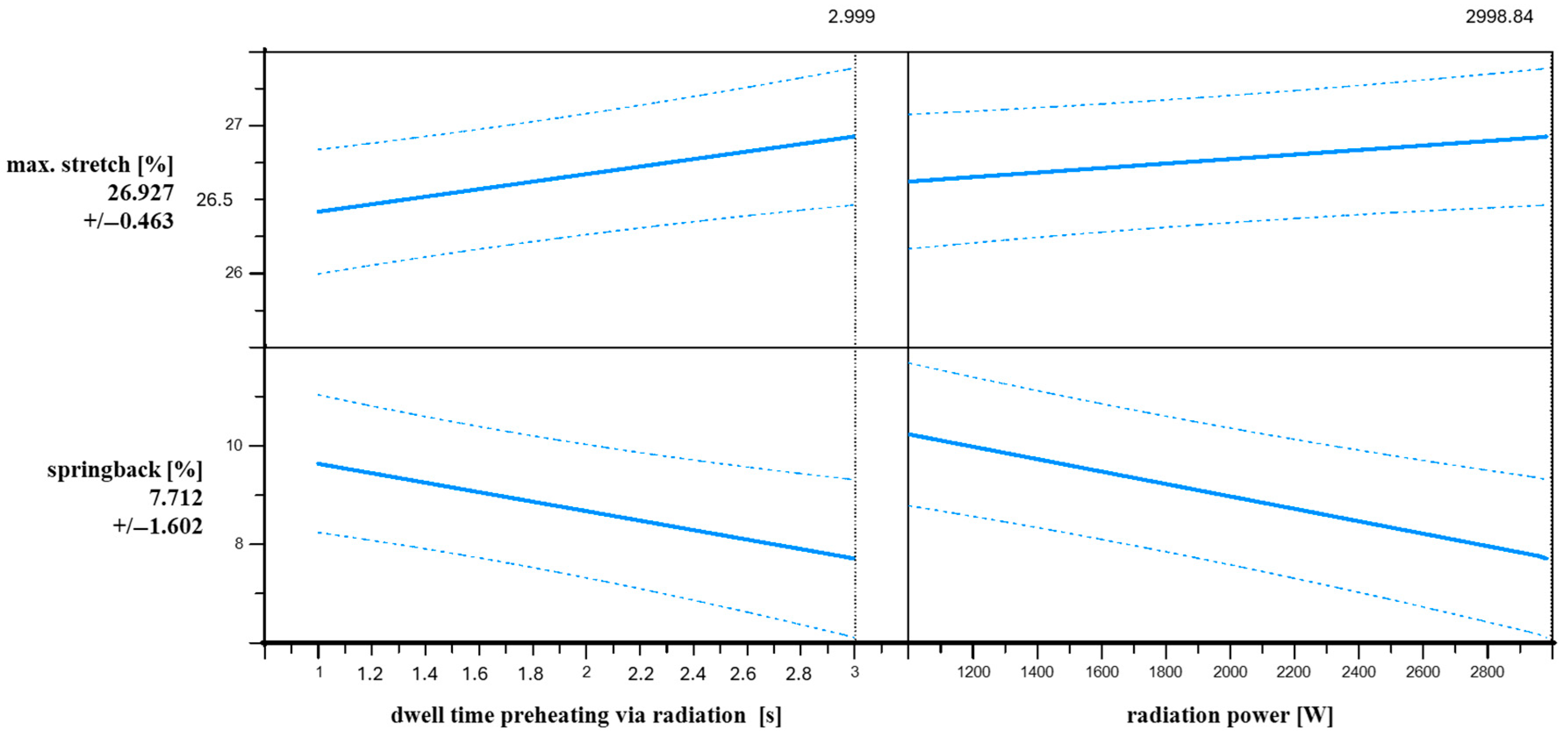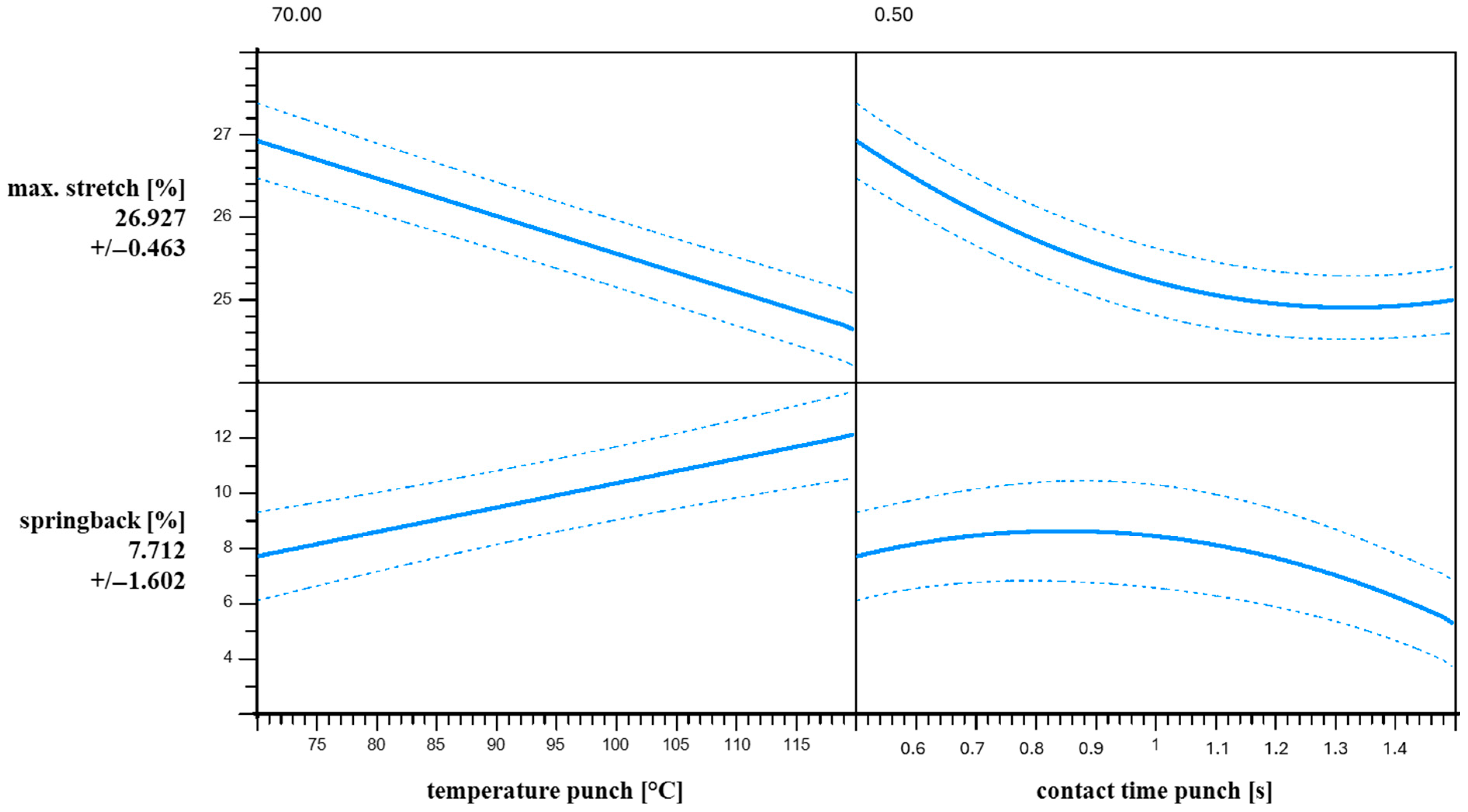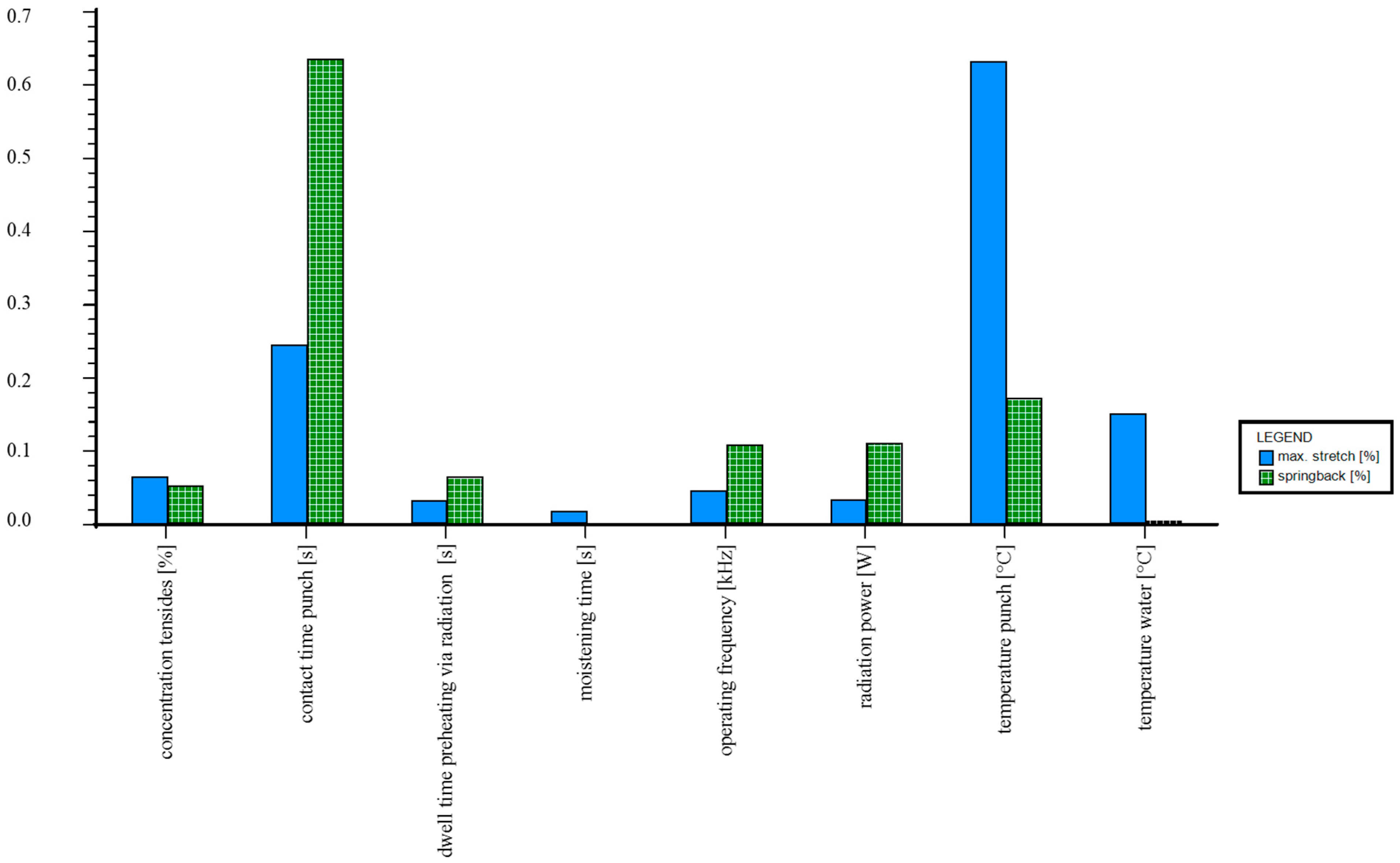3.1. Results on Material Moisture and Temperature
The results for the initial moisture content of the trial are shown in the box plot in
Figure 4. The results reveal a non-linear relationship between humidification duration and the initial moisture content, with a curved dependency becoming apparent. Contrary to expectations that longer moistening times lead to higher moisture levels, the median value of the initial moisture content at two seconds (25.55%) is lower than that at one second (28.44%) and three seconds (29.93%). This suggests an anomaly in the moisture absorption curve.
This deviation does not align with the typical curve progression seen in standardized water absorption tests such as the automatic Cobb test, even though the same physical mechanisms are at work. According to Krolle (2014), water absorption in porous materials like paper follows a three-stage process [
10]:
Range 0–0.5 s: Surface wetting and filling of surface topography, characterized by a steep increase in absorption.
Range 0.5–x s: Pore and capillary filling alongside initial fiber swelling, leading to a flattening of the curve.
Range x–60 s: Further fiber swelling and additional pore volume due to fiber movement during swelling, causing a continued decrease in the curve slope.
One plausible explanation is the D-optimal experimental design used in the study. This design, while statistically efficient, results in fewer data points for certain time intervals, increasing the potential for measurement error. Additionally, the use of an ultrasonic bath may have contributed to the variation, as the effect is higher according to the data.
Another influencing factor is the concentration of surfactants. Contrary to prior findings, the addition of surfactants in this study led to a decrease in initial moisture content. The median value dropped from 28.53% without surfactants to 25.49% at a concentration of 0.06%. This outcome contrasts with studies such as Adam et al. (2009), which assert that surfactants improve wetting by lowering water’s surface tension [
29], and with Krolle (2014), who reported enhanced absorption in uncoated paper due to capillary action [
10]. A plausible explanation for this discrepancy lies in the interaction between surfactants and soluble particles or fibers released from the paper itself. These interactions may form barriers or interfere with absorption mechanisms, ultimately reducing water uptake [
30]. Paria et al. (2005) demonstrated that both anionic and non-ionic surfactants can form a hydrophobic interfacial layer on cellulose surfaces, which may lead to reduced water absorption [
31]. To verify whether this effect also applies to the system investigated in the present study, it would be necessary to examine not only varying surfactant concentrations (below CMC, CMC, above CMC) but also different surfactant types. In particular, the inclusion of cationic surfactants is of interest, as previous studies have shown that they can significantly reduce water absorbency time due to their strong interaction with the negatively charged cellulose fibers [
32].
Higher temperatures result in an increase in initial moisture content, with a plateau appearing at higher temperatures. At 25 °C, a median value of 26.39% was measured, which increased to 28.875% at 35 °C and was 28.115% at 45 °C. This suggests that there is no substantial further increase above 35 °C. This can be explained physically by the interaction between temperature, diffusion, and the structural properties of the paper. As temperature rises, the kinetic energy of water molecules increases, enhancing molecular mobility. This accelerates the diffusion process, as the diffusion coefficient correspondingly increases [
28]. The first Fick’s law describes this steady-state diffusion process, where diffusion flux is proportional to the concentration gradient. Additionally, higher temperatures reduce water viscosity, facilitating its flow into the paper’s pores and capillaries [
33]. Thermal expansion of paper fibers also plays a role, slightly altering the pore structure and influencing absorption capacity [
10].
The influence of operating frequency [kHz] is particularly pronounced. A frequency of 40 kHz leads to a notable increase in initial moisture content. At 0 kHz, a median value of 22.61% was measured, while at a frequency of 40 kHz, it rose to 32.55%. The min–max range between the two measurement levels extends from 16.51% at 0 kHz to 38.42% at 40 kHz. Ultrasound (US) plays a central role by overcoming the intermolecular attraction forces between water molecules through cavitation. This process creates gas bubbles that expand, contract, or implode, thereby opening capillaries and enhancing water absorption [
14,
15]. Furthermore, ultrasonic vibrations loosen cellulose fibers in the paper, creating additional capillaries and voids that increase water uptake, particularly in the initial seconds of wetting [
10]. Additionally, ultrasound may expose hydroxyl groups, strengthening interactions between fibers and water [
30].
The operating frequency of 40 kHz was found to have the greatest influence on the initial moisture content, whereas surfactant concentration and water temperature showed moderate effects. In contrast, the duration of humidification had only a minor impact on the final moisture levels achieved. When compared to other studies, the moisture contents reached in this investigation were significantly higher. For instance, Stotz et al. (2022) reported the highest moisture content using the water bath method. In their study, a dwell time of 4 s resulted in a moisture content of 25.87% [
24]. The effectiveness of this method is particularly evident in the sharp increase in moisture with longer dwell times: a dwell time of only 1.6 s led to 19.52%, whereas extending the duration to 4 s increased the moisture content substantially. In contrast, spray moistening methods demonstrated considerably lower moisture levels. Stotz et al. (2022) found that using a two-substance nozzle for spray moistening yielded a maximum moisture content of just 11.08% [
24]. Franke et al. (2018) examined steam moistening and found that completely dry paper samples (0% moisture) required 14 s of steam exposure to achieve a moisture content of 25% [
9]. Pre-moistened samples, starting at 15% moisture, reached 30% after 8 s. These results suggest that although steam moistening can lead to high moisture levels, it typically requires significantly longer exposure times than other techniques.
In conclusion, the use of ultrasonic-assisted water bath moistening accelerates water absorption in paper, making this method considerably more effective than traditional approaches when integrating it into a process machine operating at typical cycle speeds of 20–40 cycles per minute. Unlike spray moistening, which results in low moisture levels, or steam humidification, which requires long exposure times, the ultrasonic water bath enables rapid and substantial moisture uptake, highlighting its superior efficiency for achieving high moisture contents in short durations. In this study, only an operating frequency of 40 kHz was investigated. However, examining different frequency levels would be of interest.
In
Figure 5, on the left, the temperature profile is shown as a function of the dwell time preheating via radiation [s]. The
x-axis represents the dwell time preheating via radiation in seconds (s), divided into three groups: 1, 2, and 3 s, while the
y-axis displays the temperature of the paper [°C]. The investigation of temperature development in relation to the dwell time preheating via radiation reveals a clear trend. At a dwell time of one second, the average temperature is 28.09 °C, with the median at 28.17 °C. The measured values fluctuate between a minimum of 22.00 °C and a maximum of 34.67 °C. When the dwell time is increased to two seconds, the average temperature rises to 32.45 °C, with the median slightly lower at 31.84 °C. In this case, the temperature values range from 28.67 °C to 38.00 °C. At a dwell time of three seconds, the average temperature is 31.68 °C, with a median of 30.67 °C. Here, a larger range of measured temperatures is observed, spanning from a minimum of 25.33 °C to a maximum of 41.67 °C. These results illustrate that the temperature tends to increase with the dwell time preheating via radiation. While the highest temperatures were recorded at three seconds, there is also greater variability in the values observed.
Figure 5, on the right, shows the moisture content as a function of preheating duration. At a dwell time preheating via radiation of 1 s, the average moisture content is 25.53%, while the median is 25.77%. The measured values fluctuate between a minimum of 17.39% and a maximum of 35.08%. For a dwell time of 2 s, the moisture content is slightly lower on average at 25.24%, with the median being slightly lower at 23.95%. The moisture values vary between 16.78% (minimum) and 34.45% (maximum). At a dwell time of 3 s, the average moisture content decreases further to 24.11%, with a median of 24.42%. In this case, the values range from 14.25% (minimum) to 34.00% (maximum). The moisture content of the paper shows a slight decreasing trend with increasing dwell time preheating via radiation. While the highest moisture content occurs at 1 s (35.08%) and the lowest at 3 s (14.25%), the average moisture content decreases slightly with longer preheating times, from 25.53% at 1 s to 24.11% at 3 s. At the same time, there is certain variability in the measurement results, with the range of measured values remaining relatively large across all dwell times.
The relatively low temperatures, ranging from 22.00 °C to 41.67 °C, can be partly explained by the enthalpy of vaporization, as a considerable amount of energy is required to evaporate moisture, resulting in a cooling effect at the paper surface and in the surrounding air [
20]. The strong variation in the measured temperatures may be partly attributed to the measurement method, as data were collected in separate test runs using a calibrated infrared sensor (Testo 845); a continuous inline measurement could provide more consistent and reliable results.
In contrast to the present study, Stotz (2022) utilized servo-driven heating plates operating within a temperature range of 100–200 °C [
24]. As a result, average paper temperatures of 39.26 °C after 4 s and 49.92 °C after 1.6 s of contact were reported. The corresponding moisture contents ranged from 16.21% to a maximum of 30.33%.
The most significant difference between the two approaches lies in the underlying mechanisms of heat and mass transfer during the preheating process, specifically, between conductive and radiative heating. Unlike conduction, radiative heat transfer is governed by a non-linear dependence on temperature: the radiative heat flux is proportional to the fourth power of the absolute temperature, as described by the Stefan–Boltzmann law [
34]. This results in efficient energy transfer only at high temperature gradients, but also in increased energy losses compared to conductive heat transfer [
19,
20]. When radiation is used, the surface of the paper absorbs the incident energy up to a certain penetration depth, while a portion is reflected [
22]. The absorbed energy raises the temperature, initiating evaporation of moisture [
23].
Based on this theoretical and experimental background, it is assumed that although radiative preheating is generally less efficient in terms of direct energy transfer compared to conductive heating, it may result in a different temperature and moisture distribution due to the distinct physical heat transfer mechanisms. To achieve higher temperatures within the paper at a given moisture content, an increase in dwell time or radiation power may be required. A suitable approach to gain a deeper understanding of the underlying mechanism would be the use of a physical simulation, supported by experimental data acquisition—similar to the methodology employed by [
25].
Figure 6 illustrates the relationship between the contact time of the punch, the moisture content before forming, and the moisture content after forming. The contact time of the paper with the punch (
x-axis) affects the moisture content after forming (
z-axis). Longer contact times lead to lower moisture content after forming. Higher initial moisture content leads to higher moisture content after forming.
Figure 7 illustrates the relationship between punch temperature, moisture content before forming, and moisture content after forming. The punch temperature (represented on the
x-axis) influences the moisture content after forming (shown on the
z-axis): as the punch temperature increases, the moisture content after forming decreases. It is also evident that a higher moisture content before forming (depicted on the
y-axis) results in a proportionally higher moisture content after forming.
Punch temperature and contact time significantly influence the paper’s moisture content after the forming process. A longer contact time leads to greater moisture evaporation, reducing the moisture content after forming. At the same time, a higher initial moisture content before forming results in a proportionally higher moisture content after forming. This suggests that the initial moisture content of the paper is the most important predictor of the final moisture content after the forming process. A similar effect is observed with stamp temperature: higher stamp temperatures lead to increased moisture loss during forming. Here, the paper’s thermal conductivity plays a role, as absorbed heat is distributed within the material, accelerating moisture evaporation [
18]. However, both contact time and stamp temperature have a relatively minor impact on final moisture content compared to the initial paper moisture content. The reason for this observation is that the stamp only contacts a small area of the measured paper sheet during the forming process. The stamp penetrates the material and first touches the paper at its lowest point. As the downward movement continues, the contact area expands. However, due to the experimental setup as an indentation test, the stamp never fully contacts the entire paper surface, leading to localized drying of the paper.
3.2. Empirical Analysis for Maximum Stretch and Springback
Starting from reference values obtained without preconditioning, the samples exhibited a maximum stretch of 26.43%, representing a doubling of the initial values. This was achieved under the following conditions: moistening time of 3 s, punch temperature of 70 °C, contact time of 0.5 s, radiation time of 1 s, radiation power of 3000 W, a tenside concentration of 0.06 %, water temperature of 25 °C, and an operating frequency of 40 kHz. The paper temperature during this trial was 34.67 °C, and the corresponding moisture content was 25.13 %.
The lowest stretch value was 21.29%, which occurred under the following conditions: moistening time of 1 s, punch temperature of 120 °C, contact time of 1.5 s, radiation time of 3 s, and radiation power of 3000 W. The water temperature was 45 °C, no frequency was applied, and the paper temperature at the time of forming was 30.33 °C. The corresponding moisture content of the paper was 14.25 %. Images of the specimens with the lowest and highest stretch are shown in
Figure 8, along with a reference specimen formed at maximum stroke without any preconditioning of the material.
Across all samples, the mean stretch was 23.96%, and the median stretch was 23.80%, indicating a nearly symmetric distribution of stretch values.
Regarding springback, the maximum value observed was 16.32%, under the following settings: moistening time of 3 s, punch temperature of 120 °C, contact time of 1.0 s, radiation time of 3 s, and radiation power of 1000 W. The tenside concentration was 0.06 %, water temperature was 45 °C, and an operating frequency of 40 kHz was applied. The paper temperature at the time of measurement was 28.0 °C, and the moisture content of the paper was 30.51 %.
The lowest springback measured was 4.20%, occurring under a moistening time of 2 s, punch temperature of 120 °C, contact time of 1.5 s, radiation time of 2 s, and a radiation power of 3000 W. No tenside was used, the water temperature was 45 °C, and the system operated without frequency input. The paper temperature was 31.0 °C, and the moisture content at that point was 20.79 %.
The average springback across all data points was 9.53%, with a median of 9.42%, suggesting a slightly right-skewed distribution in the dataset.
A stepwise regression based on a cubic model was performed using Camline Cornerstone software (Version 8.1). The resulting models demonstrated a high degree of fit, with an R-squared value of 0.978 for the maximum stretch model and 0.842 for the springback model. These values indicate that approximately 97.8% and 84.2%, respectively, of the variance in the dependent variables can be explained by the included predictors. The corresponding adjusted R-squared values—0.957 for maximum stretch and 0.788 for springback—further confirm the robustness of the models, accounting for the number of predictors and mitigating potential overfitting.
The statistical analysis revealed several model terms with highly significant effects on the response variable. In
Table 2, the significance values of the main effects are presented. Among the main effects, concentration of tensides [%] showed the strongest influence, with a
p-value of 6.38 × 10
−9, indicating a very robust contribution to the model. Other significant main effects included moistening time [s] (
p = 1.53 × 10
−4), temperature of the punch [°C] (
p = 5.44 × 10
−3), and contact time of the punch [s] (
p = 4.62 × 10
−6). In contrast, operating frequency [kHz] was the only main effect with no statistical significance (
p = 0.0994), suggesting minimal or inconsistent influence under the tested conditions.
Interaction terms also played a critical role in the model. The most significant interaction was between temperature of the punch [°C] and temperature water [°C], with a p-value of 3.66 × 10−7. Other strongly contributing interactions included moistening time × radiation power (p = 3.85 × 10−4) and contact time of the punch × radiation power (p = 0.0305). Only one interaction term—moistening time × temperature of the punch—was found to be statistically non-significant (p = 0.0978), indicating a negligible combined effect.
Quadratic terms were also included in the model. Both contact time of the punch 2 (p = 1.86 × 10−6) and moistening time 2 (p = 0.0338) were statistically significant, although the latter exhibited the weakest significance among the non-linear effects.
Table 3 presents the optimized values for key model parameters aimed at maximizing Stretch [%] and minimizing Springback [%]. Desirability functions were used to transform each response onto a standardized scale from 0 (undesirable) to 1 (fully desirable), which are then combined into an overall desirability score. The table lists the optimal values for each parameter that contribute to achieving these goals. The moistening time [s] is set at 2.67 s, ensuring optimal material preparation before further processing. The temperature of the punch [°C] is optimally adjusted to 70.00 °C, which significantly influences both stretchability and springback reduction. The contact time of the punch [s] is set at 0.50 s. The dwell time of the preheating unit via radiation [s] is determined to be 2.99 s, optimizing heat absorption before the punching process. Radiation power [W] is maximized at 2998.96 W, providing the necessary energy to enhance stretchability. Concentration of tensides [%] is optimized at 0.06%. The temperature of the water [°C] is maintained at 25.04 °C. Operating frequency [kHz] is set at 40 kHz. As a result of these optimized parameters, the maximum stretch [%] achieved is 26.93%, while springback [%] is minimized to 7.71%.
Figure 9 illustrates the optimized model for the four process parameters—moistening time, tenside concentration, water temperature, and operating frequency—on maximum stretch and minimal springback. The top row of the chart presents the model results for maximum stretch, with an optimized value of 26.93% and a standard deviation of ±0.46%. The bottom row shows springback behavior, averaging 7.71 ± 1.60%. Solid blue lines represent model predictions, dashed lines indicate confidence intervals, and vertical dotted lines mark the optimized parameter setpoints.
The moistening time has a significant effect on maximum stretch. An increase in moistening time leads to greater extensibility, with the effect plateauing after 2.6 s. This behavior suggests that the paper reaches a saturation point beyond which additional moisture does not further improve formability. The observed trend aligns with previous findings by Franke et al. (2018) and Östlund et al. (2011), which highlight that increased moisture uptake enhances stretchability, particularly in the cross direction (CD) [
8,
9]. At the same time, the tensile strength tends to decrease in the machine direction (MD), indicating a trade-off between flexibility and mechanical integrity. Moisture makes the fiber network more pliable, but oversaturation can cause swelling and irreversible changes to the fiber structure [
10], which may negatively impact mechanical performance. Moistening time did not show a statistically significant influence on springback and was thus excluded from the corresponding model.
Tenside concentration also shows a clear and consistent influence on maximum stretch and springback. As surfactant concentration increases, maximum stretch improves, and springback decreases. A concentration of 0.06% yields noticeable improvements, which supports earlier findings by Franke et al. (2021), who reported a positive influence of the use of soapy water on moldability [
35]. This effect is attributed to the reduced internal frictional resistance due to the soap treatment.
Water temperature affects both properties in opposing ways. As temperature increases, a decrease in maximum stretch is observed alongside a modest increase in springback. Elevated temperatures accelerate moisture absorption, as reported by Middendorf (2000), which can initially enhance extensibility [
33]. However, this rapid absorption may also contribute to fiber swelling and structural degradation if not properly controlled [
10] (Krolle 2014). The observed decline in stretch and rise in springback with increasing temperature may thus result from excessive moisture uptake leading to weakened inter-fiber bonding and decreased structural integrity.
Lastly, the operating frequency of ultrasonic treatment in the water bath exhibits a notable effect. Higher frequencies lead to slight increases in maximum stretch and decrease in springback. Ultrasound facilitates moisture absorption through cavitation, which disrupts the attractive forces between water molecules, forming gas bubbles that open capillaries within the paper [
14,
15]. These effects are further supported by Krolle (2014), who describes how ultrasonic vibrations loosen cellulose fiber networks, increasing porosity and water accessibility [
10]. This enhancement is particularly pronounced in the early stages of wetting. Moreover, ultrasound exposes hydroxyl groups on the fiber surface, intensifying interactions between water and cellulose [
30]. These changes contribute to improved material pliability, which can be directly linked to improved forming behavior and potentially better compressibility. To gain a deeper understanding of the effects of ultrasound and the influence of frequency, it is advisable to investigate a broader range of frequencies. A range between 20 kHz and 80 kHz would be particularly relevant to assess whether 40 kHz truly represents the optimal setting for the forming outcome. Additionally, it would be of interest to evaluate whether frequency variations affect fiber detachment, the resulting surface properties of the formed cavities, and fiber deposition in the water bath. Higher frequencies may potentially yield improved results in these aspects due to finer cavitation dynamics [
28].
Figure 10 illustrates the optimized model for the two process parameters—preheating time and radiation power—on maximum stretch and minimal springback. Both preheating time and radiation power show a direct effect on formability. An increased dwell time results in a noticeable reduction in springback and a moderate increase in maximum stretch. Similarly, higher radiation power lowers springback and slightly enhances elongation.
Although radiative preheating is generally less efficient in terms of direct energy transfer than conductive heating, the underlying physical mechanism may lead to a different distribution of temperature and moisture within the paper.
This uniform distribution plays a crucial role in modifying the mechanical behavior of the paper. Homogeneous moistening softens the fiber network, making it more malleable and compressible. In addition, free drying during preheating—without mechanical tension—can trigger the Jentzen effect, as described by Alava and Niskanen (2006) [
36]. This phenomenon involves shrinkage of the paper fibers, particularly in the transverse direction, which results in micro-compressions. These micro-compressions can subsequently be stretched out during the forming process, further enhancing the apparent elongation and reducing residual stress.
Figure 11 illustrates the optimized model for two process parameters—temperature of the punch and contact time of the punch. Increasing the temperature of the punch has a clear impact on both springback and maximum elongation. As the temperature rises, springback increases from 7.71% to 12.07%, which can negatively affect the dimensional stability of the formed paper product. Simultaneously, maximum stretch decreases, suggesting a reduction in overall formability. These effects are likely due to the localized drying that occurs at the punch–paper interface, where heat is transferred directly from the punch to the paper surface. Unlike radiant preheating, which distributes heat uniformly through the thickness (Z-direction) of the paper, punch heating creates a steep temperature gradient originating from the point of contact. Additionally, the stamp contacts the paper sequentially, starting from the center—precisely the area undergoing the greatest deformation. During the forming process, contact with the heated punch develops progressively. At the initial stage, contact is limited to the central upper area of the material; as deformation continues, the contact zone extends both downward and outward. Thus, this central zone remains in contact the longest, leading to local drying, which stiffens the material and limits its stretchability.
The contact time of the punch plays a critical role: while a longer duration reduces springback and enhances dimensional accuracy, it also decreases maximum elongation, likely due to localized drying of the paper. However, studies such as Franke et al. (2018) suggest that extended calibration time in a heated tool can further minimize springback and support more precise forming [
9].
Unlike the findings of this study, which show reduced stretch with increasing punch temperature and contact time, earlier research reported improved paper extensibility at elevated temperatures. Salmén and Back (1980) attributed this to softening of hemicellulose and lignin due to moisture changes and thermal transitions [
6]. However, their tests used fully dried, oil-impregnated samples, excluding any drying effects during heating—conditions that differ from those in the present study, where the influence of both temperature and moisture was investigated.
Stotz et al. (2022a) also reported stretch levels up to 21% using the same paper grade, but with uniform preheating via a servo-driven heating plate [
24].
These differences likely stem from the experimental setup: in this study, heat is applied only locally via the punch during forming, with uneven spatial and temporal distribution. Nevertheless, various technologies work with heated stamps, but it is not only the maximum elongation that is important. As Marek Hauptmann (2017) describes, the compressibility of the material and its frictional properties also play a key role [
2].
According to the influence values plotted in
Figure 12, the three parameters with the greatest impact on springback [%] are punch contact time [s] (0.6356), punch temperature [°C] (0.1723), and radiation power [W] (0.1114). This suggests that punch contact time is the most critical factor in minimizing springback.
In summary, the analysis of influencing factors allows us to determine the most important parameters for both target variables. Punch temperature [°C] has the highest influence on maximum stretch [%] and is also the second most significant factor for springback [%]. Punch contact time [s] is the strongest factor affecting springback [%] and has a considerable impact on maximum stretch [%]. Water temperature [°C] plays an important role in determining maximum stretch [%], whereas radiation power [W] and surfactant concentration [%] have significant but varying effects on both target variables. Operating frequency [kHz] is particularly relevant for springback [%].
In the conducted experiments, targeted adjustment of process parameters resulted in a springback of 7.71% and a maximum elongation of 26.93%. These values represent a significant improvement compared to previous studies by Stotz et al. (2022), which used a similar setup and the same paper material. In that earlier work, maximum elongation values of 21% were achieved [
24]. The paper web was first moistened in a water bath, partially dried with rubber blades, and then heated using servo-controlled heating plates at either 100 °C or 200 °C for defined periods. The primary difference between the studies lies in the preheating method. While the previous study used a heated lower plate, the current research applied radiation preheating combined with a heated punch. The results suggest that homogeneous preheating via radiation enhances maximum elongation by enabling more uniform heat distribution and targeted warming of the material.
With regard to the interaction of temperature and moisture on the formability of paper, positive results were also reported in the study presented by Franke et al. (2018) [
9]. While the present study focuses on the elongation behavior of the material, the steam humidification approach described by Franke et al. (2018) emphasizes compressive deformation [
9]. While it improves dimensional accuracy and fold distribution, a significant disadvantage is the longer cycle time: Franke et al. 2018 showed that pre-moistened samples only reach a saturation of 30% after 8 s, while dried samples require up to 14 s [
9]. The method investigated here enables faster process control. The comparison shows that steam humidification can be advantageous but requires longer cycle times.
The springback remains largely constant in the range of 10–12% across many process parameters, with only minor fluctuations. However, one significant factor influencing the springback is not taken into account in the test setup: since no die is used in the cupping test, the material is less compressed. The compression could be influenced by the integration of a heated die. Different temperature levels within the die would be of particular interest in this context. Studies show that a longer calibration time in a heated mold can reduce this effect and enable more precise shaping [
9].
Overall, it can be concluded that challenges arise despite positive effects: Waviness impairs dimensional accuracy, fibers dissolve in the water bath, and the high residual moisture must be removed before filling the cavities. In addition, inline processing is not possible within this work, and real-time measurements are lacking. One solution could be the use of NIR sensors for non-contact measurement of moisture and temperature. As these parameters were only recorded in separate test runs, more precise measurement technology would be helpful in order to better analyze correlations and improve process stability.
